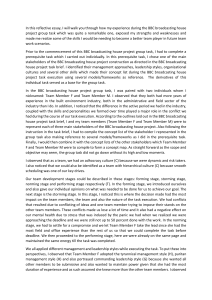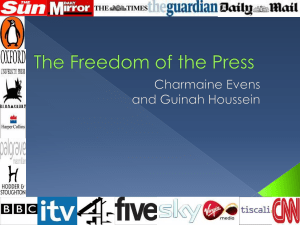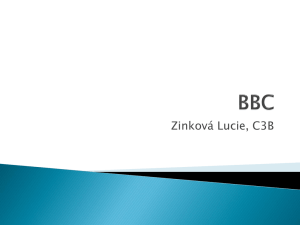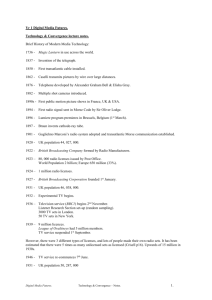Music and Radio: Histories – Futures
advertisement
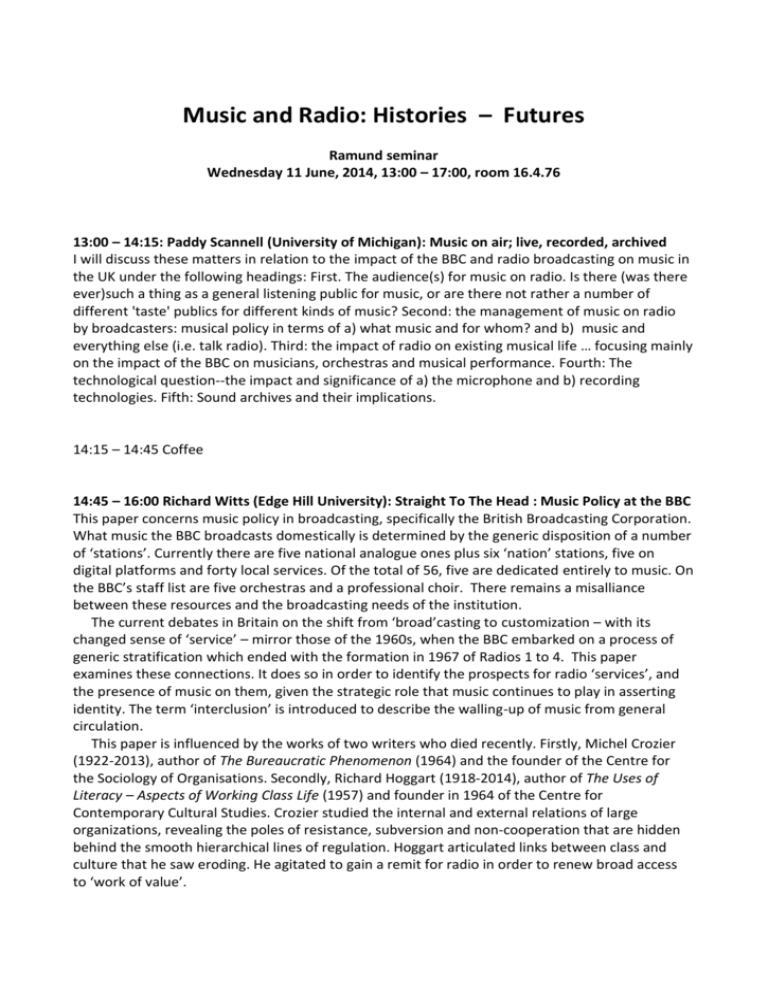
Music and Radio: Histories – Futures Ramund seminar Wednesday 11 June, 2014, 13:00 – 17:00, room 16.4.76 13:00 – 14:15: Paddy Scannell (University of Michigan): Music on air; live, recorded, archived I will discuss these matters in relation to the impact of the BBC and radio broadcasting on music in the UK under the following headings: First. The audience(s) for music on radio. Is there (was there ever)such a thing as a general listening public for music, or are there not rather a number of different 'taste' publics for different kinds of music? Second: the management of music on radio by broadcasters: musical policy in terms of a) what music and for whom? and b) music and everything else (i.e. talk radio). Third: the impact of radio on existing musical life … focusing mainly on the impact of the BBC on musicians, orchestras and musical performance. Fourth: The technological question--the impact and significance of a) the microphone and b) recording technologies. Fifth: Sound archives and their implications. 14:15 – 14:45 Coffee 14:45 – 16:00 Richard Witts (Edge Hill University): Straight To The Head : Music Policy at the BBC This paper concerns music policy in broadcasting, specifically the British Broadcasting Corporation. What music the BBC broadcasts domestically is determined by the generic disposition of a number of ‘stations’. Currently there are five national analogue ones plus six ‘nation’ stations, five on digital platforms and forty local services. Of the total of 56, five are dedicated entirely to music. On the BBC’s staff list are five orchestras and a professional choir. There remains a misalliance between these resources and the broadcasting needs of the institution. The current debates in Britain on the shift from ‘broad’casting to customization – with its changed sense of ‘service’ – mirror those of the 1960s, when the BBC embarked on a process of generic stratification which ended with the formation in 1967 of Radios 1 to 4. This paper examines these connections. It does so in order to identify the prospects for radio ‘services’, and the presence of music on them, given the strategic role that music continues to play in asserting identity. The term ‘interclusion’ is introduced to describe the walling-up of music from general circulation. This paper is influenced by the works of two writers who died recently. Firstly, Michel Crozier (1922-2013), author of The Bureaucratic Phenomenon (1964) and the founder of the Centre for the Sociology of Organisations. Secondly, Richard Hoggart (1918-2014), author of The Uses of Literacy – Aspects of Working Class Life (1957) and founder in 1964 of the Centre for Contemporary Cultural Studies. Crozier studied the internal and external relations of large organizations, revealing the poles of resistance, subversion and non-cooperation that are hidden behind the smooth hierarchical lines of regulation. Hoggart articulated links between class and culture that he saw eroding. He agitated to gain a remit for radio in order to renew broad access to ‘work of value’. 16:00 – 16:15 Break 16:15 – 17:00 Morten Michelsen (University of Copenhagen): Interbellum Radio Spaces In the paper I would like to suggest three spatially defined categories for discussing the new soundscapes caused by the gramophone, the telephone and especially radio. All three categories describe how radio may contribute to the ordering of the world for the radio listener. They represent three different perspectives on radio listening moving from the private to the public, from the micro-social to the macro-social, from place to space. The first category focuses on the workings of radio in the home and on individuals in the home. How does radio (partially) determine home, individual space, and individuality. The second focuses on the relation between home and radio understood as a public medium. Here the product (the radio program) is more central than the listener. The third concentrates on radio as cultural and societal structural force. Here radio in its societal context is important. If you would like to participate, please send an e-mail to momich@hum.ku.dk to ensure sufficient amounts of coffee About the presenters: Paddy Scannell worked for many years at the University of Westminster (London) where he and his colleagues established, in 1975, the first undergraduate degree program in Media Studies in the UK. He is a founding editor of Media, Culture and Society which began publication in 1979 and is now issued six times yearly. He is the author of A Social History of British Broadcasting, 19221939 which he wrote with David Cardiff, editor of Broadcast Talk and author of Radio, Television and Modern Life. He is currently working on a trilogy. The first volume, Media and Communication, was published in June 2007. Professor Scannell is now working on the second volume, Television and the Meaning of 'Live.' The third volume, Love and Communication, is in preparation. His research interests include broadcasting history and historiography, the analysis of talk, the phenomenology of communication and culture and communication in Africa Richard Witts is Reader in Music and Sound at Edge Hill University. A former music performer in classical music and post-punk, he was a presenter for BBC TV and radio. Richard’s thesis examined the history of BBC’s music policy. His most recent book is a study of the music of The Velvet Underground (Indiana University Press), and he has contributed chapters to a number of books, including the Cambridge Companion to Recorded Music (2012) and Kraftwerk: Music Non-Stop (2011, Continuum). Morten Michelsen is associate professor in musicology at the University of Copenhagen. He has focused on popular music, e.g. in a book on US and UK rock criticism (Rock Criticism from the Beginning, 2005), in one on Danish rock culture (Rock in Denmark, 2013), and in shorter analyses of the music of Björk, Bowie, Metallica, and Michael Jackson with a focus on the sound parameter. Michelsen is also engaged in the establishment of the research field of sound studies in Denmark and in Europe. Right now he is chair of the European Sound Studies Association ESSA and member or head of a series of research projects concerned with sound and radio. His special focus here is interbellum music-radio relations.
